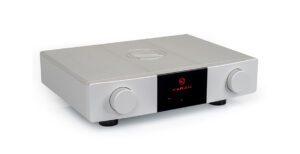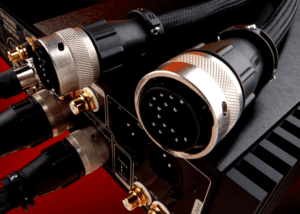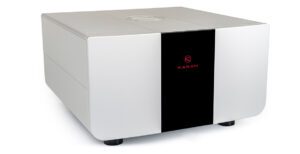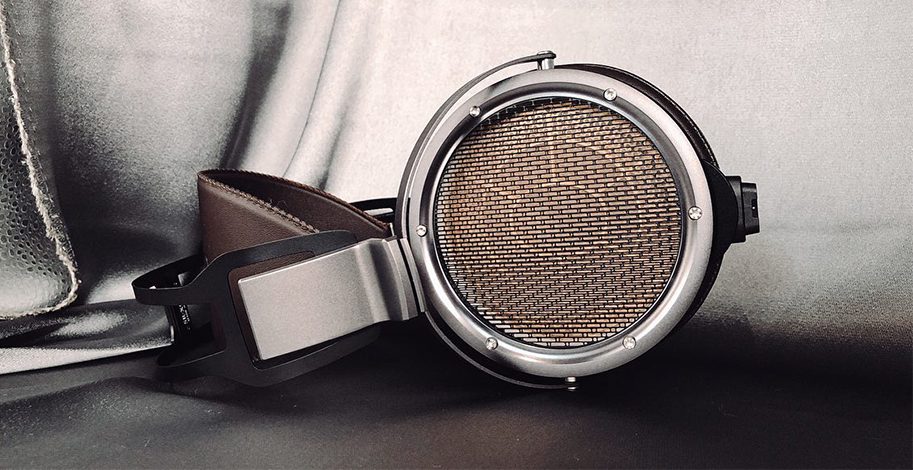
Only one company has been making electrostatic headphones almost exclusively since its inception (the only exception being its portable electret in-ears), and that firm is Stax. Its Lambda line of headphones were the reference standard in electrostatic headphones for many years. Only recently have other firms embarked on electrostatic designs. Currently there are offerings from Audeze, Warwick Acoustics, Shure, Koss, Dan Clark, Sennheiser, and HiFiMAN vying for audiophile dollars. Given all this intense competition, Stax has introduced a new flagship, the SR-X9000 (£5,195). Coupled with the SR‑X9000 headset, Stax has its top-of-the-line amplifier (all electrostatic headphone designs require a dedicated power amplifier that is different from conventional headphone amplifiers), the hybrid SRM-T8000 (£4,395). We reviewed the amplifier (back when Stax still called them ‘energizers’) in Issue 167, but both headphones and amp will be reviewed primarily as a package here—and what a powerful package it is.
Technical Tour
The electrostatic technology employed by the SR-X9000 was originally developed for the SR-X headset. It has evolved over the years. The latest design, which Stax calls MLER-3, which stands for Multi-Layer Electrodes, evolved from the MLER‑2, which can be found on the Stax SR‑009 headset. There are four separate layers to the MLER‑3 stator. Stax is especially proud of its latest manufacturing prowess, which involves bonding the etched electrode and metal-mesh electrode using a diffused junction via thermocompression bonding.
The SR-X9000, like the previous flagship, the SR‑009, has a round shape to the headset rather than the rectangular one used for many years in Stax’s Lambda line. The circular shape makes it possible to employ a metal mesh for the fixed electrodes. But the problem with a mesh is its lack of rigidity. When first employed on the SR‑Ω, Stax reinforced the mesh with a special adhesive which could only be applied by hand. For the SR-X9000 Stax developed a less labour-intensive solution for mass production that accomplishes the same result.
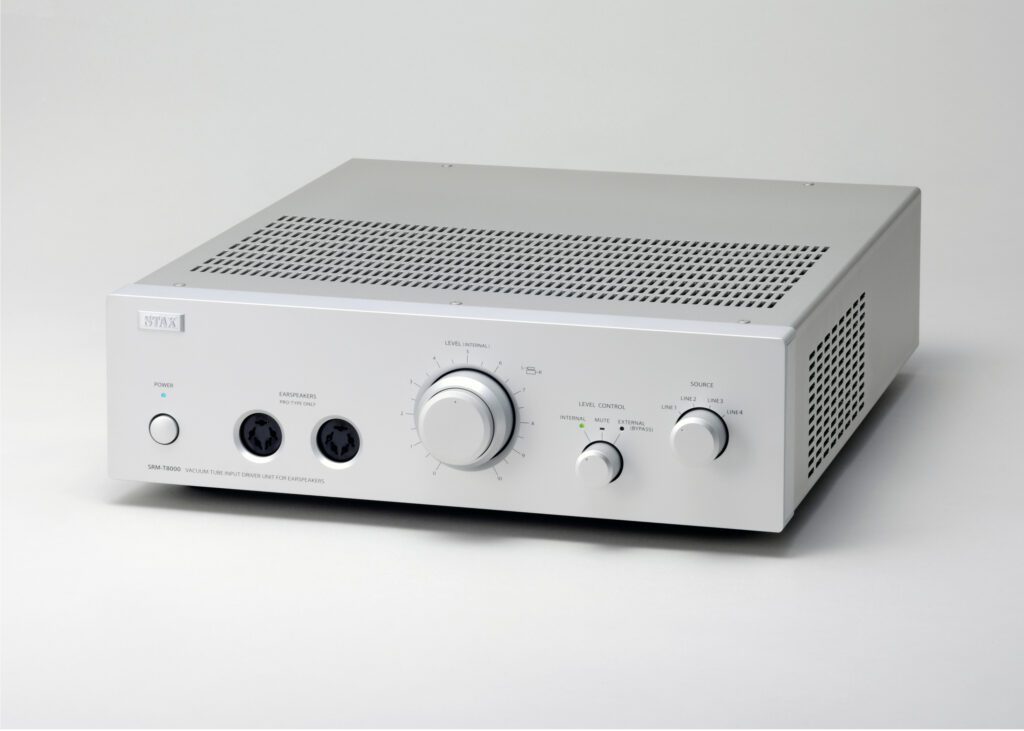
Diaphragm diameter on the SR-X9000 has been increased by 20% over that of the SR-009, which, according to Stax, improves performance. Like all electrostatic designs, the SR-X9000 diaphragm is made of an extremely thin plastic film. To protect the film surface there’s always a grille guard. On the SR-X9000, this guard has been angled slightly via different length stand-off pillars, so it does not directly reflect the sound coming from the diaphragm.
The SRM-T8000 headphone amplifier is a hybrid design that uses two 6922 dual-triode tubes in the first stage and a high-current emitter follower transistor amplifier in the output stage. With its balanced amplifier configuration Stax eliminated the need for a transformer or inverting stage after the XLR balanced input. Stax even looked at the rubber feet and opted for a new, fire-resistant, extremely hard rubber that according to Stax “hardly slides when placed on a table etc. Please lift up when you move it.”
Ergonomics and Setup
What are the ergonomic considerations when deliberating on a pair of headphones? For me the primary consideration has always been fit. While heavier than the Stax SR-407 (one of my pairs of Stax), the SR-X9000 will be a more comfortable listening experience for many potential users, especially those with large heads and ears. That added comfort is due in part to the larger ear openings and thicker earpads. The SR-407’s opening is just wide enough to fit my whole ear in comfortably (I have small ears) and make a decent seal around them; however, many other users will find that their ears are cramped. The SR-X9000 provides quite a bit more space around your ears, so that a wider range of ear sizes will remain comfortable.
The SR-X9000 headband is metal rather than the plastic used on the SR-407 and earlier Lambda models. Unlike the SR-407’s headband, which can be easily broken (I’m on my third SR-407 headband), the SR-X9000 headband should be able to withstand normal abuse. My only quibble with the SR-X9000 headband is that it does not allow for quite as small a head size as the earlier models. I needed to wear a baseball cap to raise the headphone’s position slightly on my tiny head.
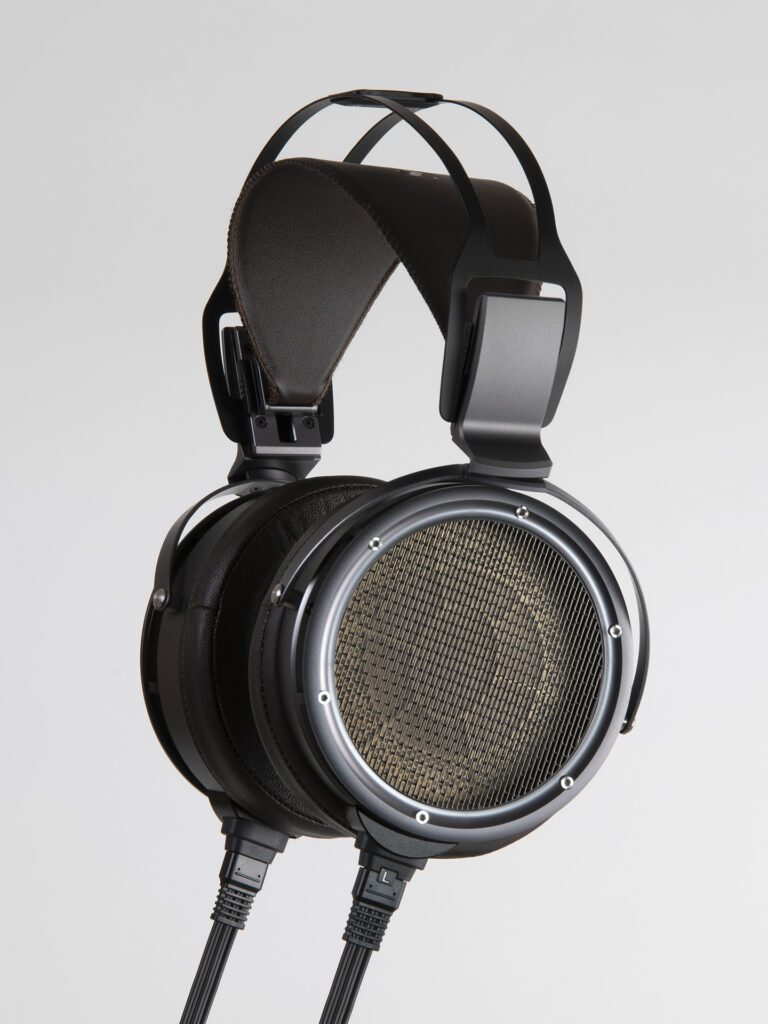
Unlike earlier Stax designs, the SR-X9000 has a removable and replaceable cable. The connections are robust with excellent strain relief. The cable itself is a bit lighter and even more flexible than the cables permanently attached to the Lambda and SR-407 model. This also opens up the possibility of third-party cables. While I find the stock Stax cable to be perfectly adequate, I’m sure that some audiophiles will relish the opportunity to add ‘cable swapping’ to their potential Stax modifications.
The primary reason for listening through headphones has always been for private, single-party listening that does not disturb others. The Stax, like other open-capsule headphones, does not attenuate the escaping sound as much as a closed-enclosure design. While certainly quieter than a loudspeaker, the SR-X9000 still produces a high enough volume level to the outside world that you can hear music, when it’s being played at medium levels, from several feet away. In comparison, the Dan Clark Stealth headphone is silent at that same distance.
The SRM-T8000 amplifier’s back panel has three analogue inputs (but four input options on the front input selector). One of the inputs is a balanced XLR while the next two are single-ended RCA. The back panel also has a ‘Parallel Out,’ which can be attached to a power amplifier, active loudspeaker, or second headphone amplifier. The SRM-T8000 front panel provides for two ‘Pro bias’ Stax headphones, but no connections for earlier ‘Standard bias’ models. The front panel is dominated by the centrally located volume control, which allows you to change each channel level individually to adjust balance, if needed. The front panel also has an input selector knob and a three-way ‘level control,’ which allows you to use either the internal volume control or bypass it and allow the external input level to be passed through to the headphones and the parallel output. The third setting is ‘mute.’
While this three-way setup provides more flexible options than if the volume control were always in the circuit, it also makes it possible to blow up your headphones or the device connected to the parallel output! If you have your DAC (or other input source) connected and set to fixed level output (which is usually the maximum output level of the device) and the SRM-T8000 set to bypass, that full output level will be produced, and the result could be bad. Stax is aware of the potential issue and has cautions and warnings in its instruction manual. Most of the time I chose to adjust the volume via the volume control on the source device to avoid the possibility of frying any of my gear.
While the SRM-T8000 has four input selection options on the front panel, it only has three inputs. The fourth input is a panel for an option card. I enquired as to the nature of the card’s function. After a few days, Stax representative informed me that initially there were plans for an additional module, but they are currently not offering anything to fill that void. A DAC module would be a welcome addition that would increase the SRM-T8000’s ergonomic features to the same level as the Warwick Bravura and Sonoma electrostatic amplifiers.
Sound
Stax earphones have long been known for their open sound, big soundstage, fast transients, explicit detail, and airy bass. Although these sonic characteristics aren’t limited to Stax headphones, since all electrostatic headphones share the same basic technology, Stax has the longest track record producing electrostatic headphones; electrostatic sound has become Stax’s sonic trademark. But even among Stax models there has never been just one consistent harmonic balance or soundstage characteristic. Some long-time Stax fans still speak longingly of the harmonic balance and bass punch of Stax SR-X compared to the early Lambda series. Even some SR-009s owners have discovered they prefer the slightly more forgiving sound of the Lambda SR‑L700 Mk2 or SR-007 compared to the SR‑009s on more aggressively mixed and recorded music.

When I reviewed the Stax L-700 (for The Absolute Sound) in 2016, I did not retain them through purchase or loan because I found their overall sound was only slightly superior to the pair of SR-407 I already owned. Yes, the L-700 bass was a bit more extended than the SR-407, but the rest of its harmonic balance was strikingly similar. Currently I have two older Stax headsets on hand, the SR-407 and a pair of SR-X Mark 3s. I also have a Stax SRM-007T ‘Japan-Only’ headphone amplifier that requires a step-down transformer to power its 100-watt Japanese standard. At one time Stax got the clever idea to make sure that amps designated for domestic Japanese sale were not transhipped or resold overseas by cutting the leads inside their transformers so they could not be converted to other standards, as earlier models had been. It worked as well as can be expected. Owners used a transformer to step down the incoming AC power to the amp to 100 volts. The transformer also isolates the amplifier further from AC line noise.
I have blathered on about the SRM-007T because I used it for a three-way Stax headset comparison. Since the SRM-007T has three outputs, two for Pro bias and one for the earlier Standard bias, I could hook up the SR-X9000, SR-407, and SR-X Mark 3 all at the same time for rapid A/B/C comparisons between them. The only tricky part of this testing setup was that none of the three headsets have the same sensitivity. The SR-X was the least sensitive, while the SR-407 was the most sensitive, The SR-X9000 sat between them. The difference between them was somewhere around 3dB, so I had to adjust the volume level for each headset.
For this comparison I hooked up a Sony NW-WM1Z digital-audio player via its single-ended output to the SRM‑007T. I used my own live concert recordings as well as commercial references for the comparisons. One release that has proved to be especially useful due to its excellent sonic and artistic qualities is Six Spoons of Honey by Alexis Harte. The song ‘Things That Matter’ is a favourite.
After even a short listen the sonic differences between the three headsets were immediate and obvious. The SR-X had a definite midbass bump that gave it some nice thunk but little output below that. In comparison, the SR-407 had less of a midbass bump with more low bass extension, though the bass rendition was on the ethereal side. Through the SR-X9000 the bass had dynamic power and full extension to the lowest notes. While perhaps not a bass monster like the Sony MDR-Z1R, the low bass notes are still there with impact; you don’t have to strain to hear them.
The SR-X9000 had the most relaxed, natural, and unstressed midrange of the three headphones. In comparison the other two sounded peakier in the 3kHz region and not as smooth throughout. Combined with this smoother midrange response, the SR-X9000 produced the best soundstage. It was more coherent and produced a most precise image. In comparison the SR-407 did not define each instrument’s dimensions as clearly. The SR-X’s soundstage was noticeably smaller than that of the other two headsets, with the spatial information reduced and compressed into a more limited soundfield.
It was obvious that the SR-X9000 was clearly the best-sounding Stax I’ve experienced. It combined all the sterling aspects of the Stax sound into a more natural and more musical presentation, while retaining Stax’s exemplary low‑level detail and resolution.
My last A/B comparison was to pit the SR-X9000 coupled to the SRM-T8000 with the Warwick Sonoma system. While my Warwick system employs the first-generation Sonoma headset rather than the latest Bravura headset, it is still close to the sound of the current model I reviewed in TAS Issue 326. For this A/B comparison I hooked up the Sony portable player I’d used in earlier tests to both the SRM-T8000 and the Sonoma amplifier via a special RCA cable/splitter that has a split cable that allows two devices to be fed from the same output. (I also use it when I must bi-amp via RCA connections.)
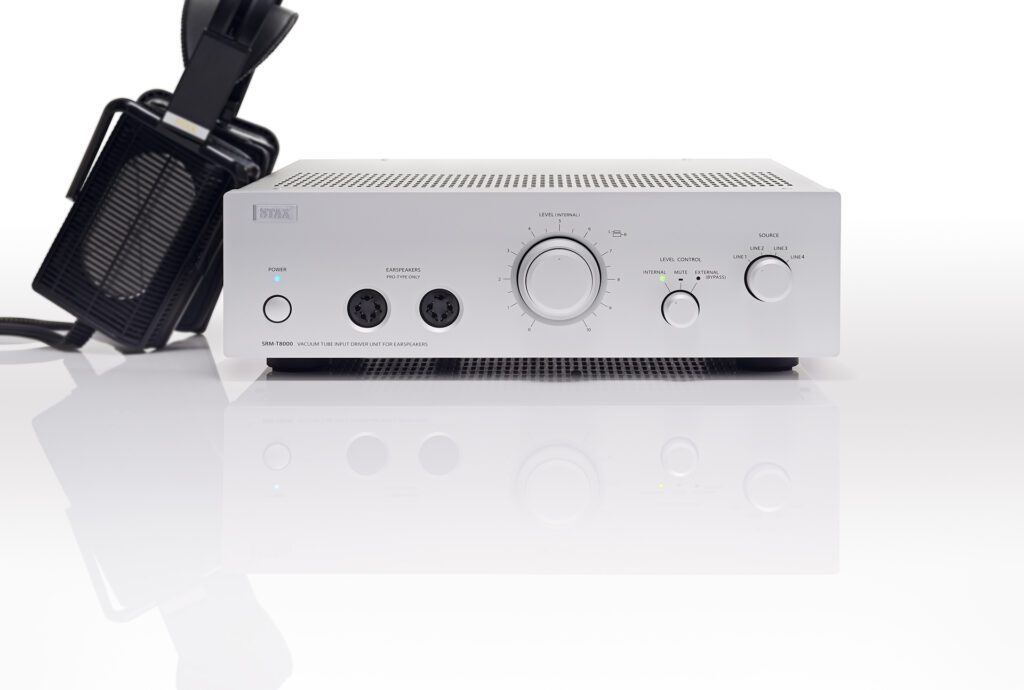
Putting aside comfort differences for the moment (the SR-X9000 headset will be preferred by those with larger heads and ears while the Sonoma fits small ears like mine perfectly). The first sonic difference between the two electrostatic systems was the more extended dynamic contrast of the SR-X9000 compared to the Sonoma. Dynamic peaks seemed louder through the Stax. The next most noticeable difference was in soundstage sizes. The SR-X9000 had a slightly more spacious rendition with a bit more space between instruments.
One area where the two electrostatic systems were strikingly similar was how smooth and mellifluous their midrange presentations were. Bass extension was similar with a slight edge to the Stax on tightness and definition. Both did a superb job of rendering everything, even nasty recordings, listenable without robbing them of their verve. In overall sonics, the Sonoma system comes in a very close second to the Stax flagship system. Given the price differential between the two systems (the Stax is almost 1.5× the Warwick’s price), the Warwick system is a fine value (it also adds a good internal DAC, to boot). Unless you are doing direct matched-level A/B comparisons I doubt you will find the Warwick system sonically wanting, but when compared to the Stax, it came in second place.
Summary
I have no doubt that the Stax SR-X9000 ranks as Stax’s finest effort to date. It checks all the boxes to qualify as a world-class, reference-level headphone when combined with the SRM-T8000 amplifier. Whether it stands head and shoulders above its competition is another matter that is not as clear-cut, and since I have not heard the SR-X9000 compared to all its competition on a level playing field (few, if any folks have), I can’t make such a judgment. There are some great headphones, both planar dynamic and electrostatic, that are also of reference quality and offer the SR-X9000 fierce competition.
And then there is the matter of supply. I was given a short window for this review because Stax had scheduled the system to be at a headphone show both before and after my review period. In both cases the system was sent to retailers. This only happens when a manufacturer has very few samples available, and this was surprising given Stax reputation and supposed recapitalization. So, if you want a pair, you may have to wait a while to get them, but for some audiophiles and Stax devotees, the wait will be worth it.
Technical specifications
Electrostatic headphone
- Impedance 110 ohms (including cable) at 10kHz
- Sensitivity NA
- Weight 432 grams without cable
Electrostatic headphone amplifier
- Inputs One balanced XLR, two unbalanced RCA
- Outputs Two “Pro level” headphone outputs, single ended RCA volume-controlled or line level
- Maximum output voltage 470Vrms
- System price £9,560
Manufacturer
Stax
UK distributor
Symmetry
+44(0)1727 865 488
Tags: ELECTROSTATIC HEADPHONE HEADSET HEADPHONE AMPLIFIER SR-X9000 SRM-T8000 STAX

By Steven Stone
More articles from this authorRead Next From Review
See all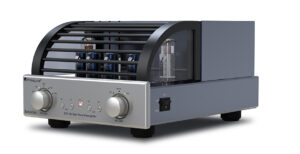
PrimaLuna EVO 100 phono preamplifier
- Apr 22, 2024
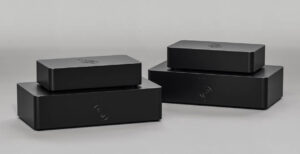
Reiki Audio SuperSwitch Master Pro + Servant Pro
- Mar 27, 2024
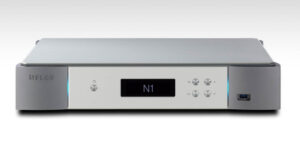
Melco Audio N1-S38 music server
- Mar 27, 2024








